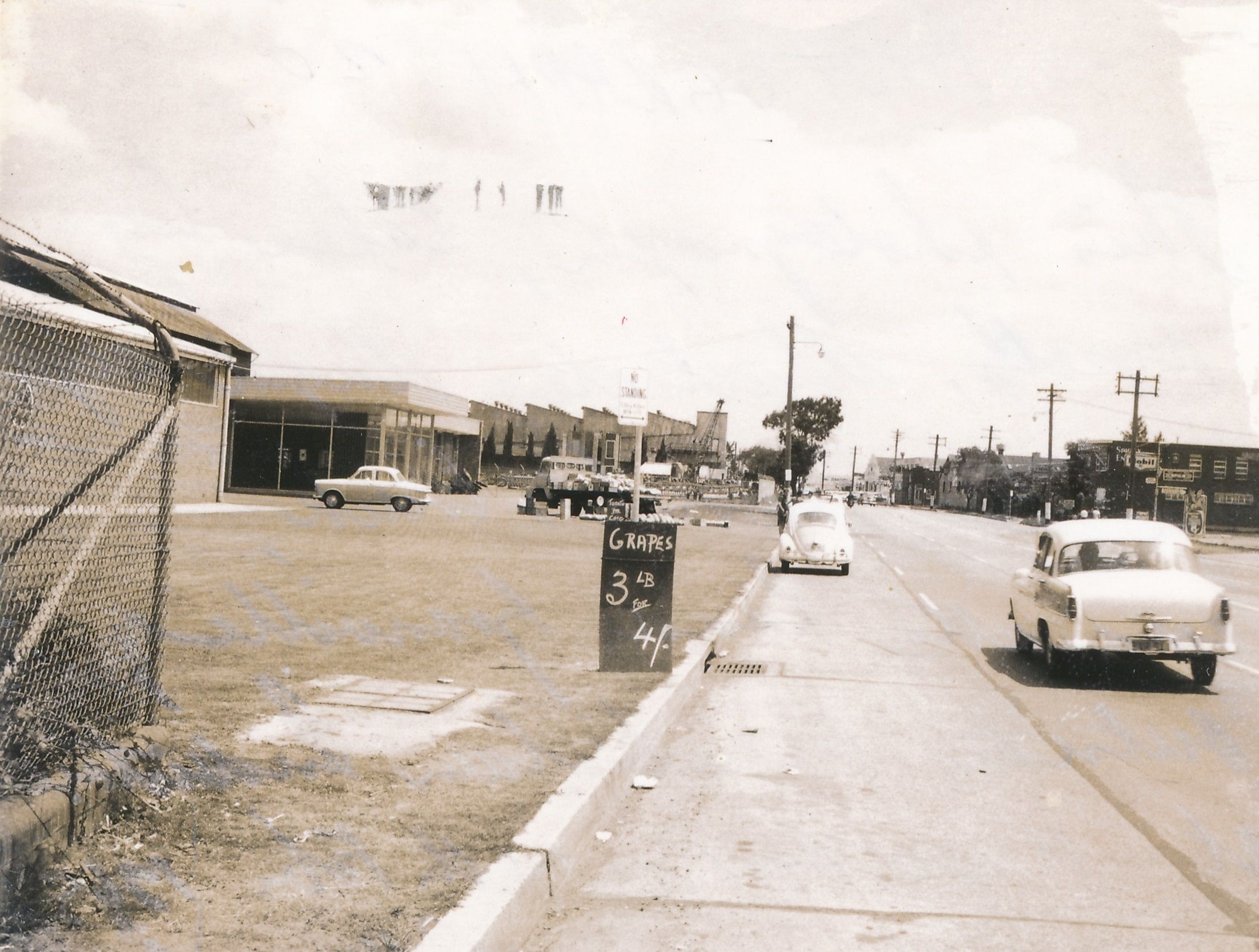
Parramatta Road is the oldest highway in Australia, and one of the country’s most significant roads.[1] Although now bypassed in places by motorways, Parramatta Road remains a major arterial route across Sydney, linking the city with the Western Suburbs.
British Colonists adopted the route shortly after their arrival in the Parramatta area in 1788, and only minor changes to the old Colonial highway route have been made since 1797[2]. The Colonial highway itself was mapped over an ancient path tread by people of the Eora and Darug Nations for countless generations, as they travelled between coast and inland to access resources and to gather for social and ceremonial occasions.[3]
Parramatta Road, running 35 kilometres, cleaves a path from Broadway in the City of Sydney to the City of Parramatta, passing through a number of suburbs on the way including Leichhardt, Ashfield, Burwood, Homebush, Lidcombe, Auburn and Granville.[4] Parramatta Road also forms the first section of the Great Western Highway, a major road route that continues through and beyond Parramatta and, with different road names, over the Blue Mountains to Bathurst.
The most Westerly section of Parramatta Road fell within the boundaries of the Parramatta City Council local government area from 1948, and prior to that date under one of Parramatta’s precursor Councils, the Municipality of Granville. A reduced, but historically significant, section of Parramatta Road continues to fall under the City of Parramatta Council following the 2016 Council Amalgamation boundary changes.
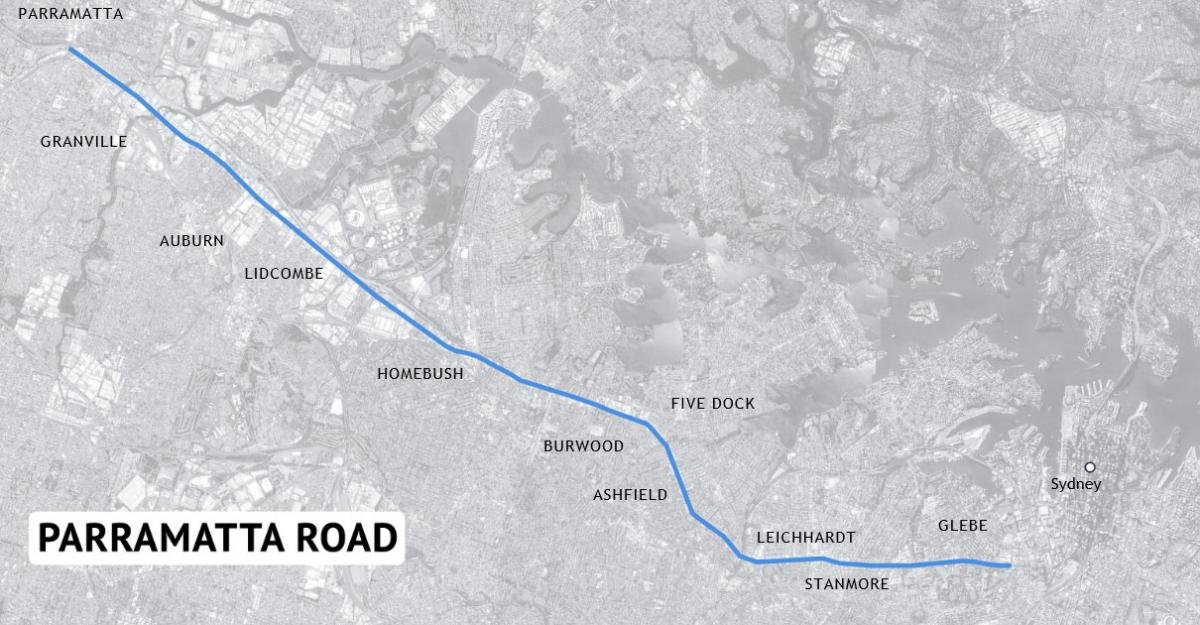
(Sydney Morning Herald, 01/08/2018)
Early History
Shortly after establishing the settlement at Sydney Cove in 1788 the British Colonists, under the Administration of Governor Captain Arthur Phillip, began to seek more fertile land on which to grow crops.[5] A journey up the river heading inland from the coast (now Parramatta River) lead to the establishment of a settlement, originally known as Rose Hill. In 1792, the settlement was renamed Parramatta (the name derived from the one used by the traditional custodians of the area, the Burramattagal people, meaning ‘place where the eels lie’).[6] Due to the lush and fertile lands and plentiful river estuary at Parramatta the area quickly became the ‘breadbasket’ of the colony, providing much-needed agricultural produce for the growing community.[7]
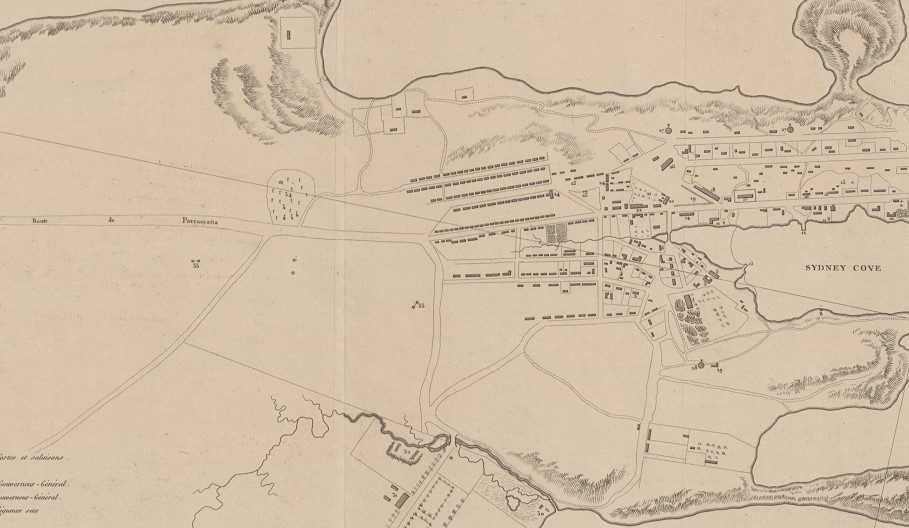
(Source: National Library of Australia, Ref. 230676724)
For some time, Parramatta River remained the predominant route of transport between Sydney Cove and Parramatta for the British Colonists, being a much faster and less perilous journey than the land journey .[8]. However, over time, the colonists also began to undertake the journey overland, following an ancient walking track that had been used by the First Peoples of the area for generations. The route became increasingly important for the colonists as a means for transferring produce and livestock between Sydney Cove and Parramatta. The road was widened to allow passage by wheeled vehicles in 1794. In 1797 further improvements to the road were made, although it was still little more than a cart track and became a quagmire after rain.[9]
A fascinating description of a journey along the route was recorded in the memoirs of Harriet Blaxland, an early settler to the Colony, in 1807:
“My earliest memory of the colony commenced with a journey of 15 miles from Sydney to Parramatta. The road – a cart track only the width of the wheels, the wild natural forest almost closing overhead, still and silent as it was, can never be forgotten”[10]
Tollgates and a paved road
When Lieutenant-Colonel Lachlan Macquarie arrived as the fifth Governor of the Colony of New South Wales in 1810, one of his first acts was to improve the roads.[11]
The route to Parramatta had deteriorated signifiantly since its improvements in the 1790s , and was in dire need of repair, so convict chain gangs were put to work improving the road. In 1810 toll gates were installed, with the Sydney tollgate standing close to the area now known as Broadway, and the Parramatta tollgate installed close to A’Beckett’s Creek, in what is now the suburb of Granville.
The toll gates were leased to individuals, with the fees used by the colonial administration to fund road maintenance.[12] The Parramatta tollgate was later moved to a site closer to Boundary Road. Now long gone, the history of the Parramatta tollgates is fascinating, with one of the tollgates featuring in an infamous local murder.
On 10 April 1811 the road, newly-paved in stone, was opened to some fanfare, although still primarily used to transport agricultural produce from the fertile lands in the West to the settlement at Sydney Cove.
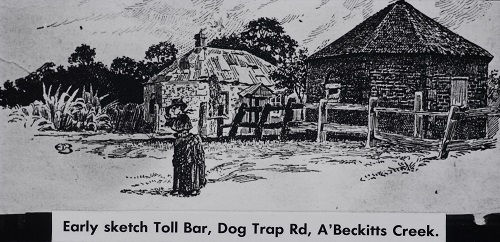
(Source: City of Parramatta Council Local Studies Library Photographic Collection, LSP00369)
A trade route for produce and livestock
During the earliest years of the colony “a familiar sight” along the route to Parramatta “was the slow-moving bullock dray laden with wool or other produce from the interior”.[13]
The route was also used for driving livestock, a practice that continued until surprisingly recent times. Historic correspondence files held in the City of Parramatta Council Archives contain a number of letters of complaint regarding the use of Parramatta Road by drovers during the night.
In one such letter dated 1931 (Mrs) Edith Malcolm, acknowledges that “we know the cattle must be driven down the road”, but asks “is all this yelling like maniacs, continual cracking of whips, and yelping of seemingly dozens of dogs, all necessary?”.[14]
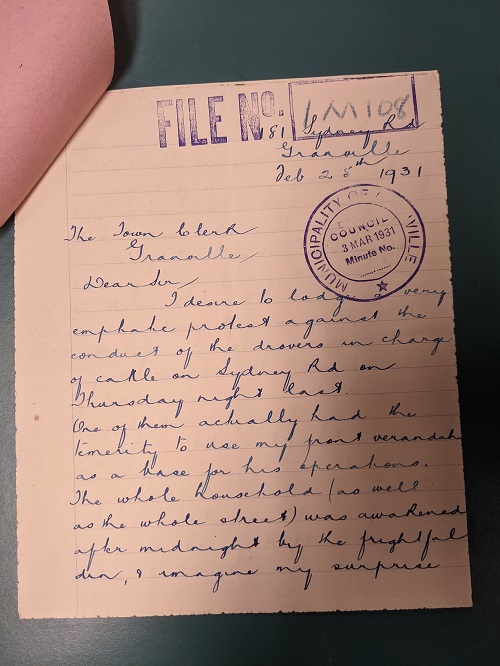
(Source: Granville Correspondence Files, City of Parramatta Archives)
A stagecoach service is introduced
By the 1820s, the potential for transporting people, as well as produce and livestock, along the route to Parramatta was recognised, and in 1821 the first commercial stagecoach route commenced.[15]
However, despite Governor Macquarie’s considerable investment in improvement initiatives, the condition of the road connecting Parramatta and Sydney Town remained poor, and journeys were still long and uncomfortable. The journey could also be dangerous, with travellers risking an encounter with Bushrangers. Ironically, many of the bushrangers are believed to have been absconded convicts from the chain gangs consigned to undertake road improvements in the Parramatta area and nearby[16]. One such local bandit, Jack Donahue, is credited by some to be the inspiration for the fictional Bushranger Jack Duggan in the Australian-Irish traditional ballad “Wild Colonial Boy”.[17]
Throughout the 1820s to the 1850s several stage coach services operated between Sydney Town and Parramatta, with varying success, with a round trip in good weather taking around 3 hours.[18] The route by this time had come to be known as Parramatta Road at its Eastern end and Sydney Road at its Western end, logical names given a traveller’s destination when departing to or from either location.[19]
The struggling stagecoach services enjoyed a last flourish of success when carrying hopeful prospectors from Sydney Town via Parramatta to the goldfields of Bathurst during the ‘Gold Rush’ of 1855.[20] By this time, many inns and stagecoach houses had sprung up along Parramatta Road to cater for those making the long road journey west.
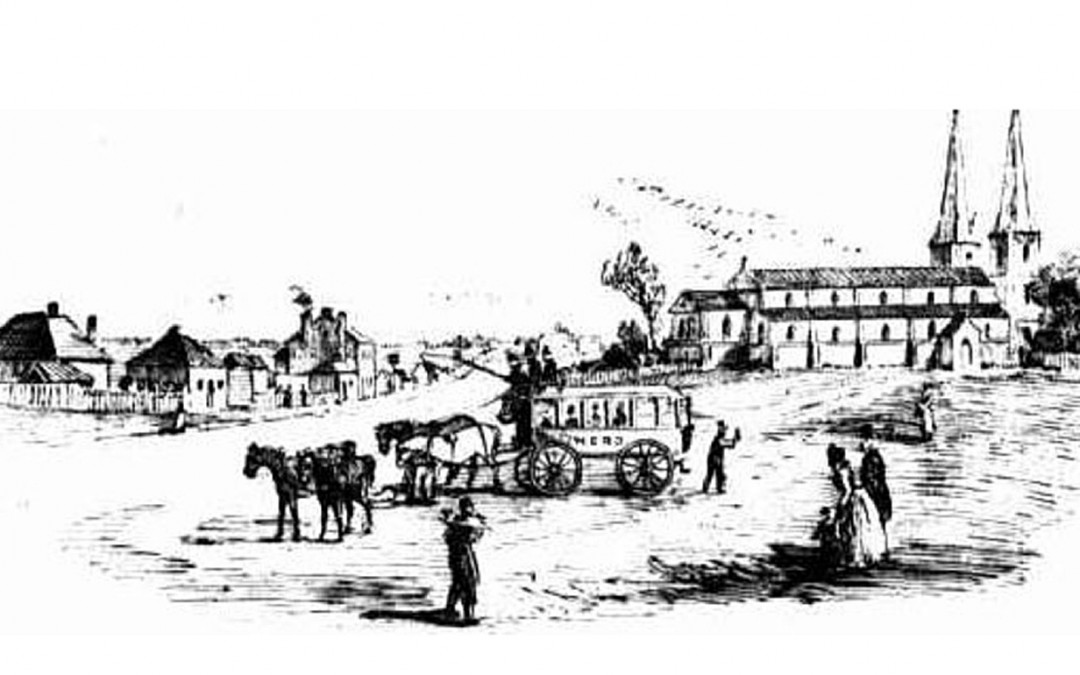
(Source: Cumberland Argus and Fruitgrowers' Advocate, 26/12/1896, p.10
One such hotel catering for travellers on Parramatta Road was the Heritage-listed Vauxhall Inn in Granville. Constructed in the early 1850s, the inn caught the tail end of the surge of stage coach passengers heading to the goldfields in the West. However, within only a few years the majority of the inn’s patrons arrived via a novel and very different form of transport as the railway reached Parramatta in 1855.[21] For many decades, the railway became the preferred route between Sydney and Parramatta and the coming of the railway initiated a terminal decline for the stage coach services. [22]
The fast, efficient and comfortable railway journey to Parramatta lead to the opening up of large swathes of nearby land as housing subdivisions, to cater for Sydney’s growing population. As the township of Parramatta grew and thrived during the late nineteenth century, Parramatta Road became little-used and mostly a route for local traffic journeys.
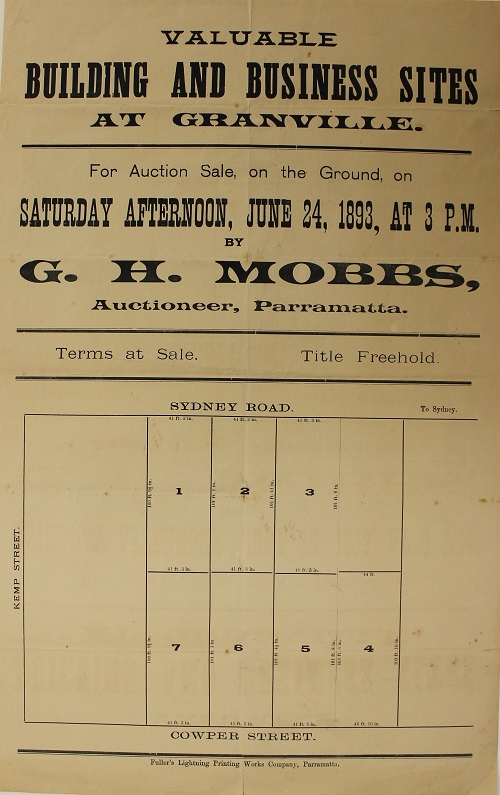
(Source: City of Parramatta Community Archives, ACC108)
The rise of the motor car
However, the decline in use of Parramatta Road following the introduction of the railway saw a significant reversal from the 1920s onward, due to the introduction and exponential growth of personal car ownership. The rapid increase in motor vehicle journeys lead to a series of upgrades to Parramatta Road being undertaken during the mid-century, during which time it was extensively widened and resurfaced.[23]
Awakened from the sleepy decades of near-irrelevance, by the 1940s Parramatta Road had transformed into a pulsating economic artery conveying streams of flowing traffic in both directions, and lined with thriving business. A Heritage-listed building still standing at 138 Parramatta Road Granville, known locally as ‘The Barn’, provides a tangible example of the style of fine commercial properties that once lined the road plying their various trades.[24]
In keeping with its motor vehicle-led renaissance, from the 1940s onward, Parramatta Road also became increasingly the epicentre of a wide range of automobile requirements with services ranging from new and used vehicle sales, to mechanical repairs, tyre fitting and petrol pumping stations. Indeed, the Western end of Parramatta Road leading into Church Street, Parramatta came to be known as ‘Auto Alley’.
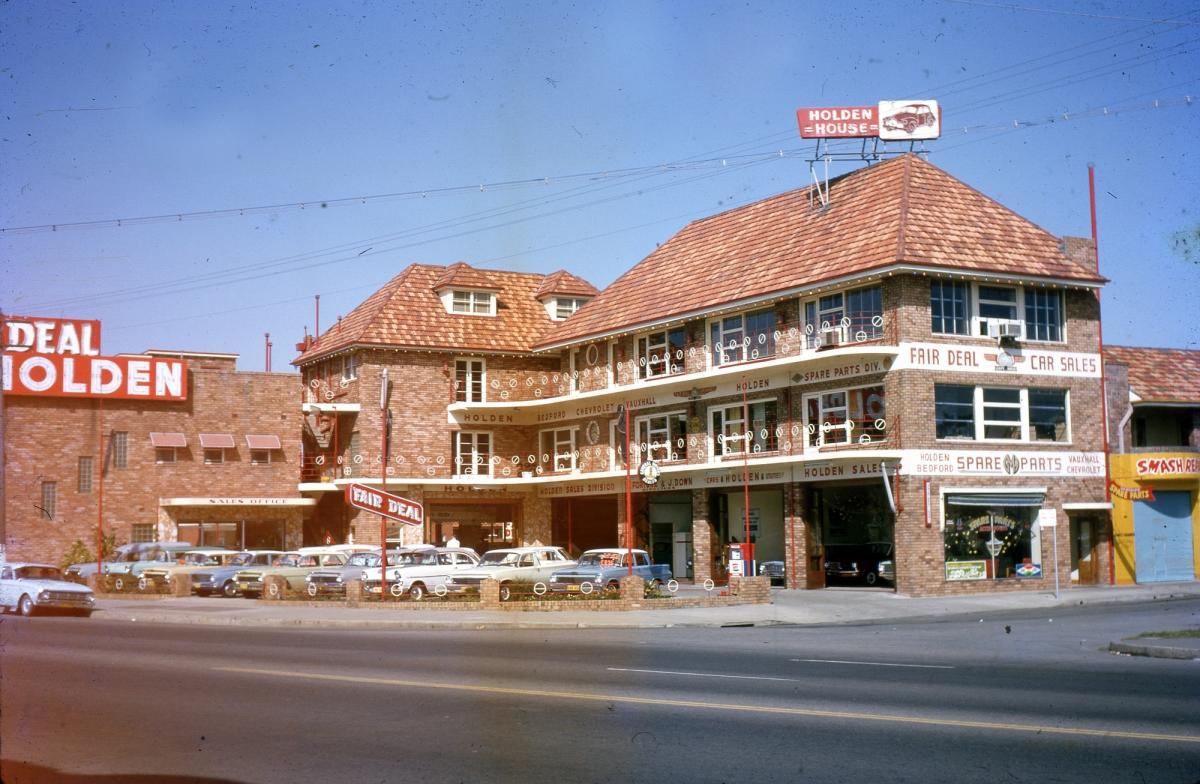
(Source: City of Parramatta Community Archives, Tremain Collection)
The communities of Parramatta Road
Post-World War 2, the economic buzz of Parramatta Road attracted many newly-arrived migrants who over the following decades established distinctive communities along its route, resulting in the opening of vibrant cafes and restaurants, and other businesses catering for local needs. The significance of the migrant history of Parramatta Road is reflected in a collaborative Council project of 2002 that saw the ceremonial naming of a street in the small town of Kfarsghab in Lebanon as ‘Parramatta Road’.[25]
Throughout the 1960s and 1970s eateries, retail premises, and commercial businesses continued to thrive along Parramatta Road. A number of new American-style motels also opened, providing rest and respite for weary travelers along the road, much as the coaching inns had done during the years horse-drawn stagecoaches had plied the route.
Congestion and motorways
During the latter half of the twentieth century, traffic congestion on Parramatta Road continued to escalate. Indeed, the 1980s saw an explosion in number of daily car activities, with 55,000 in 1981 having climbed to close to 70,000 by 1985.[26] Congestion was for a time somewhat alleviated following the opening of the M4 motorway in 1986, but soon after car activities on Parramatta Road resumed their upward trend. Parramatta Road, as far as could be imagined from the still and silent highway almost enclosed by forest in 1807, came to be described as “the ugliest stretch of road in Sydney”.[27]
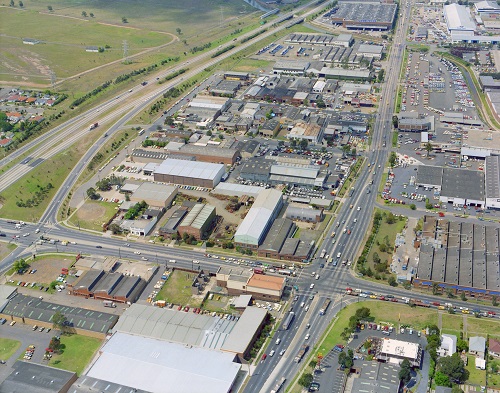
(Source: City of Parramatta Community Archives, ACC002/084/013)
Recent History
Ironically, as the new Millennium dawned in 2000, Parramatta Road’s success as a major arterial road for motor vehicles of the twentieth century ultimately began to be the cause of its subsequent shorcomings. As the road became increasingly congested and polluted, and parking became more difficult, many of the businesses that lined its route began to move elsewhere.
Despite various rejuvenation initiatives suggested over recent years, by the 2010s Parramatta Road had degenerated into a spiral of terminal decline. Indeed, ‘Parramatta Road’ is now a term synonymous with unpleasant urban settings in the form of “run-down buildings, tawdry signage and heavy traffic”[28]. There is also a high, and increasing, vacancy rate for shop-fronts lining the road.
At the western end of Parramatta, even the famous “Auto Alley” is being replaced with new property developments with an ambition to transform the spaces into a hub of mixed retail and medium to high density housing.
Reflections on a road
For many thousands of years, the First Peoples of the Sydney area travelled a path between the sandy coastal lands of the Eora and the fertile interior Darug lands . Adopted by the British Colonists who arrived in 1788, the route between Parramatta and Sydney Town developed into a colonial highway, and eventually into a major arterial road. Now in decline, ‘Parramatta Road’ has become a byword for congestion, pollution and urban ugliness. However, even in its present form, there is a raw urban beauty to Parramatta Road, resonating with the consciousness of an incalculable number of human journeys, and generations of lived experience.
Parramatta Road is embedded in our consciousness as the original land connection between Sydney and Parramatta. With only a little imagination it is possible to visualise a time when the fern-lined walking track to Burramatta passed over numerous pristine streams and afforded pleasant views of expansive tree-lined vistas. With a little more thought, we can see the horse-drawn stagecoaches lurching down a muddy stone track, and then the sleek movements of the startlingly modern motor cars of later years. We can remember and acknowledge members of the local communities of people arriving from abroad to make a new life, who through impressive entrepreneurism and hard work brought vigorous success to roadside businesses.
Drawing from this long and fascinating history we can look beyond the congestion and urban neglect to find value in, and inspiration from, this ancient route west - Parramatta Road.
By Michelle Goodman, Archivist, Parramatta Heritage and Visitor Information Centre, 2021
![]()
References
[1] Jervis, J. The Cradle City of Australia: A History of Parramatta, 1788-1961. The Council of the City of Parramatta, 1961, p. 54
[2] The Road to Parramatta. (August 1998). Heritage Council of NSW
[3] History focus for revived Parra Road. (18/04/2001). Parramatta Advertiser, p. 2
[4] A lost cause - can Parramatta Road be saved. (01/08/2018). Sydney Morning Herald. Retrieved on 27/01/2021 from https://www.smh.com.au/national/nsw/a-lost-cause-can-parramatta-road-be-saved-20180801-p4zuuo.html
[5] Kass et al, Parramatta: A past revealed. (1996). Parramatta City Council, p. 26
[6] Jervis, J. The Cradle City of Australia: A History of Parramatta, 1788-1961. (1961) The Council of the City of Parramatta, pp. 10-12
[7] Parramatta Road: Urban design competition brief, (2001). Parramatta City Council
[8] Jervis, J. The Cradle City of Australia: A History of Parramatta, 1788-1961. (1961) The Council of the City of Parramatta, p. 55
[9] Goodall, J and Plate, C, Walking the Parramatta Road: 2000 and Beyond, 2000
[10] Jervis, J. The Cradle City of Australia: A History of Parramatta, 1788-1961. (1961). The Council of the City of Parramatta, p. 55
[11] Ibid.
[12] Jervis, J. The Cradle City of Australia: A History of Parramatta, 1788-1961. (1961) The Council of the City of Parramatta, p. 55
[13] Granville Correspondence files, City of Parramatta Council Archives (PRS30)
[14] Sydney. (10/03/1821). Sydney Gazette and New South Wales Advertiser, p. 2. Retrieved on 27/01/2021 from https://trove.nla.gov.au/newspaper/article/2180137?searchTerm=stage%20coach%20parramatta
[15] Horne, C. Bushrangers. (2020). Blacktown Mayoral History Prize Entry
[16] Jack Donohue. Australian Dictionary of Biography. Retrieved on 13/01/2021 from http://adb.anu.edu.au/biography/donohoe-john-jack-1985
[17] Jervis, J. The Cradle City of Australia: A History of Parramatta, 1788-1961. (1961).The Council of the City of Parramatta, p. 56
[18] Parramatta Road Urban Design Competition Brief. (2001). Parramatta Road Steering Committee (NSW)
[19] Jervis, J. The Cradle City of Australia: A History of Parramatta, 1788-1961. (1961) The Council of the City of Parramatta, p. 54
[2] Jervis, J. The Cradle City of Australia: A History of Parramatta, 1788-1961. (1961). The Council of the City of Parramatta, p. 54
[21] The Road to Parramatta. (August 1998). Heritage Council of NSW
[22] Jervis, J. The Cradle City of Australia: A History of Parramatta, 1788-1961. (1961). The Council of the City of Parramatta, p. 54
[23] History focus for revived Parra Road. (18/04/2001). Parramatta Advertiser, p. 2
[24] The Road to Parramatta. (August, 1998). Heritage Council of NSW
[25] Now Sydney’s most famous road stretches all the way to Lebanon. (08/05/2002). Daily Telegraph, p.23
[26] NSW Transport Management & RMS Traffic Volume Viewer, 2016
[27] Now Sydney’s most famous road stretches all the way to Lebanon. (08/05/2002). Daily Telegraph, p.23
[28] The Road to Parramatta. (August, 1998). Heritage Council of NSW


